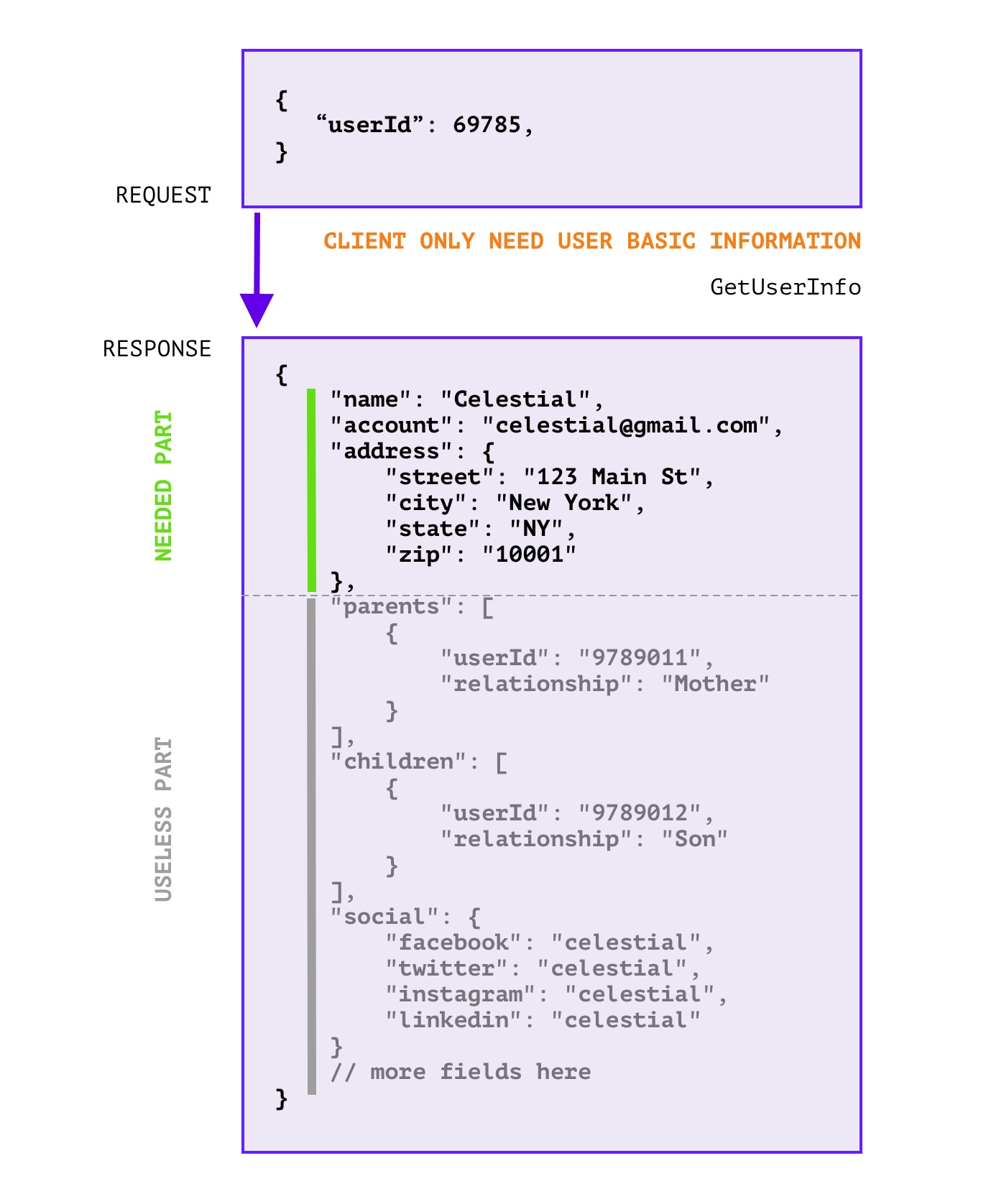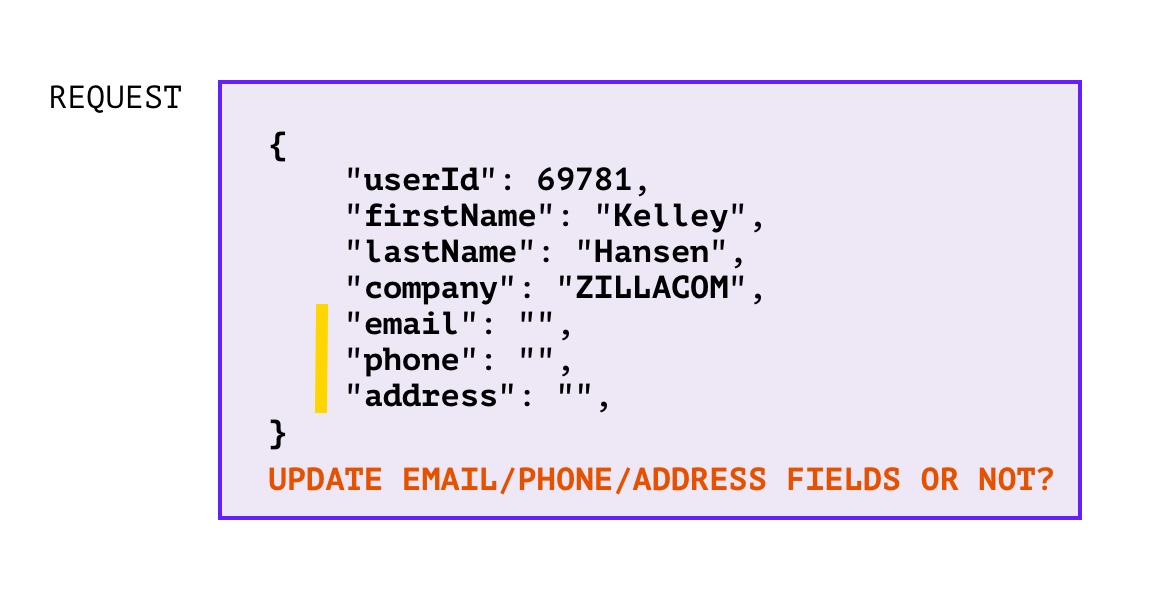背景 #
gRPC 作为服务端的常用框架,它通过 protocol-buffers 语言来定义服务,同时也约定了请求和响应的格式,这样在服务端和客户端之间就可以通过 protoc 生成的代码直接运行而不用考虑编码传输问题了。
但是,可能会遇到这样的场景:
-
RPC 响应中 无用的字段过多 , 浪费带宽和无效计算,如下图所示:
这里的无用字段是指,在响应中,没有用到的字段,这些字段可以忽略掉,不会影响客户端的使用。

或许 拆分接口 是一个好的办法,但是可能会因为这样那样的原因(信息粒度降低导致接口太多了,有些地方就是需要聚合信息;细粒度的API设计同时会导致代码重复增加),可能无法推动拆分改造。同时如果没有拆分标准,亦或团队内成员不能严格遵守标准,那么拆分也只是重复问题而已。
-
RPC 增量更新时,如何判断零值字段是否需要更新?
对于 unset 和 zero value 不好区分的语言中(比如:go),在提供服务的一方遇到 增量更新 的场景时就会遇到这样的情况:
对于这种情况当然可以也有一些方法来解决,比如:使用指针来定义数据基本类型,那么在使用的时候如果判定为
nil就说明没有设置,如果不为nil且为零值,那么就说明也是需要更新的。不过这样解决的缺点就是,nil refference panic的概率又增加了,在使用时也稍微麻烦了一点。 ·
·
解决方案 #
其实我们在思考上述两种场景的时候,把 客户端 和 服务端 的角色提取出来,就会发现这两个场景都是从 服务端 的视角遇到的问题,两个场景都是类似的:
- 客户端需要哪些字段,服务端不知道
- 客户端更新了哪些字段,服务端也不知道
但是,其实客户端是知道的,因此让客户端把这部分信息传递给服务端就行了。因此我们可以用 FieldMask 字段,用来传递客户端需要的字段,服务端就只返回需要的字段;客户端的告诉服务端需要哪些字段,服务端就更新哪些字段。
但是 FieldMask 只是一个定义,在具体的使用场景中还需要开发者自己编写一些辅助方法,来实现功能。那么是不是可以提供一个插件,让开发者可以只编写 proto 文件,便可以自动生成一些辅助方法呢?答案是肯定的,预览效果如下:
message UserInfoRequest {
string user_id = 1;
google.protobuf.FieldMask field_mask = 2 [
(fieldmask.option.Option).in = {gen: true},
(fieldmask.option.Option).out = {gen: true, message:"UserInfoResponse"}
];
}
message Address {
string country = 1;
string province = 2;
}
message UserInfoResponse {
string user_id = 1;
string name = 2;
string email = 3;·
Address address = 4;
}
message NonEmpty {}
service UserInfo {
rpc GetUserInfo(UserInfoRequest) returns (UserInfoResponse) {}
rpc UpdateUserInfo(UserInfoRequest) returns (NonEmpty) {}
}
生成的代码如下:
因为篇幅有限,对代码进行了删减,如果需要查阅完整代码请参见 github.com/yeqown/protoc-gen-fieldmask/examples/pb/user.pb.fm.go
// FieldMask 公共部分代码
// FieldMaskWithMode 根据不同的模式决定不同的使用姿势(Filter 和 Prune)
func (x *UserInfoRequest) FieldMaskWithMode(mode pbfieldmask.MaskMode) *UserInfoRequest_FieldMask {
fm := &UserInfoRequest_FieldMask{
maskMode: mode,
maskMapping: make(map[string]struct{}, len(x.FieldMask.GetPaths())),
}
for _, path := range x.FieldMask.GetPaths() {
fm.maskMapping[path] = struct{}{}
}
return fm
}
// Filter 模式下,包含在 FieldMask 中的字段代表 保留 / 更新。
func (x *UserInfoRequest) FieldMask_Filter() *UserInfoRequest_FieldMask {
return x.FieldMaskWithMode(pbfieldmask.MaskMode_Filter)
}
// Prune 模式下,包含在 FieldMask 的字段代表需要 去除 / 不更新。
func (x *UserInfoRequest) FieldMask_Prune() *UserInfoRequest_FieldMask {
return x.FieldMaskWithMode(pbfieldmask.MaskMode_Prune)
}
// UserInfoRequest_FieldMask provide provide helper functions to deal with FieldMask.
type UserInfoRequest_FieldMask struct {
maskMode pbfieldmask.MaskMode
maskMapping map[string]struct{}
}
// 增量更新的服务部分代码 (fieldmask.option.Option).in = {gen: true} 控制生成
func (x *UserInfoRequest) MaskIn_UserId() *UserInfoRequest {}
func (x *UserInfoRequest_FieldMask) MaskedIn_UserId() bool {}
// 响应字段裁剪部分代码 (fieldmask.option.Option).out = {gen: true, message:"UserInfoResponse"} 控制生成
func (x *UserInfoRequest) MaskOut_UserId() *UserInfoRequest {}
func (x *UserInfoRequest) MaskOut_Name() *UserInfoRequest {}
func (x *UserInfoRequest_FieldMask) MaskedOut_UserId() bool {}
func (x *UserInfoRequest_FieldMask) MaskedOut_Name() bool {}
// Mask 根据 FieldMask 和 mode 来裁剪响应字段。
func (x *UserInfoRequest_FieldMask) Mask(m *UserInfoResponse) *UserInfoResponse {
switch x.maskMode {
case pbfieldmask.MaskMode_Filter:
x.filter(m)
case pbfieldmask.MaskMode_Prune:
x.prune(m)
}
return m
}
func (x *UserInfoRequest_FieldMask) filter(m proto.Message) {
if len(x.maskMapping) == 0 {
return
}
pr := m.ProtoReflect()
pr.Range(func(fd protoreflect.FieldDescriptor, _ protoreflect.Value) bool {
_, ok := x.maskMapping[string(fd.Name())]
if !ok {
pr.Clear(fd)
return true
}
return true
})
}
func (x *UserInfoRequest_FieldMask) prune(m proto.Message) {
if len(x.maskMapping) == 0 {
return
}
pr := m.ProtoReflect()
pr.Range(func(fd protoreflect.FieldDescriptor, _ protoreflect.Value) bool {
_, ok := x.maskMapping[string(fd.Name())]
if !ok {
return true
}
pr.Clear(fd)
return true
})
}
又了上述的辅助代码,因此我们就可以在客户端和服务端直接使用了:
客户端侧:
func main() {
maskedReq := &pb.UserInfoRequest{
UserId: "1",
}
maskedReq.
MaskOut_Email(). // masking email field in response
MaskOut_Address() // masking address field in response
}
服务端侧:
// 响应裁剪示例
func (u userServer) GetUserInfo(
ctx context.Context,
request *pb.UserInfoRequest,
) (*pb.UserInfoResponse, error) {
// FieldMask_Filter means that the fields are included in the response,
// otherwise they are omitted.
// FieldMask_Prune means masked fields are not included in the response,
// otherwise they are included.
fm := request.FieldMask_Filter()
// fm2 := request.FieldMask_Prune()
fmt.Printf("userServer.GetUserInfo is called: %v\n", request.String())
resp := &pb.UserInfoResponse{
UserId: "69781",
Name: "yeqown",
Email: "[email protected]",
Address: nil,
}
// judge if the field masked or not, avoid unnecessary call or calculation.
if fm.MaskedOut_Address() {
// filter more, so the address field should be included.
resp.Address = &pb.Address{
Country: "China",
Province: "Sichuan",
}
}
// filter the field masked out.
_ = fm.Mask(resp)
return resp, nil
}
// 增量更新示例
func (u userServer) UpdateUserInfo(ctx context.Context, request *pb.UserInfoRequest) (*pb.NonEmpty, error) {
// FieldMask_Filter means that the fields are expected to update,
// otherwise they are ignored.
// FieldMask_Prune means masked fields are ignored to update,
// otherwise they are expected to update.
fm := request.FieldMask_Filter()
// fm2 := request.FieldMask_Prune()
fmt.Printf("userServer.UpdateUserInfo is called: %v\n", request.String())
if fm.MaskedIn_UserId() {
// userId want to be updated, so you should use request.UserId to update.
fmt.Println("userId want to be updated.")
}
return new(pb.NonEmpty), nil
}
关于 PG* 的一些总结 #
PG* 就是 protoc-gen-star 的缩写,是一个高效开发 protoc 插件的 go 语言库。
protoc-gen-fieldmask 就是以它为基础开发的一个插件(PGV也是)。比较早以前就知道了这么个库的存在,但是但是并没有什么好的点子,也就一直没有实践过,这次就顺便学习了一下这个库的一些用法:
-
基本原理
所有的插件都是配合 protoc 一起工作的,protoc 会处理源代码然后生成一个
CodeGeneratorRequest的请求,调用插件,插件处理这个请求,生成一个CodeGeneratorResponse的响应,protoc 会处理这个响应并生成文件。整个流程如下:
foo.proto → protoc → CodeGeneratorRequest → protoc-gen-myplugin → CodeGeneratorResponse → protoc → foo.pb.go -
基本用法
protoc-gen-star抽象了一个Module, 并提供一个一系列的辅助方法,因此你需要做的事就是实现这个Module。那么如何实现呢?// Module describes the interface for a domain-specific code generation module // that can be registered with the PG* generator. type Module interface { // The Name of the Module, used when establishing the build context and used // as the base prefix for all debugger output. Name() string // InitContext is called on a Module with a pre-configured BuildContext that // should be stored and used by the Module. InitContext(c BuildContext) // Execute is called on the module with the target Files as well as all // loaded Packages from the gatherer. The module should return a slice of // Artifacts that it would like to be generated. Execute(targets map[string]File, packages map[string]Package) []Artifact }重点就是
Execute方法,在其中遍历所有文件的AST,识别你的插件需要处理的特征,然后准备好一个Artifact,然后返回这个Artifact。Artifact就是预期生成的文件对象,在protoc-gen-star中,它可以是通过模板生成,也可以就是完整的文件内容。 -
如何调试你的插件
在开发过程中,调试/测试环节必不可少,那么对于依赖于 protoc 编译的插件该怎么调试呢?尤其是怎么断点调试呢?
- 日志调试
protoc-gen-star已经在ModuleBase中内置了日志记录,只需要调用ModuleBase.Debugf或者ModuleBase.Logf方法即可。- IDE 断点调试
光有日志可不够,想要追踪某个变量的值,打日志可能会让你崩溃。我们得想办法,可以在IDE中调试自己的插件。想要断点调试,那么就不能依赖 protoc, 必须得让插件可以独立运行,这样才能调试。
回顾一下前面的基本原理,我们的插件其实是依赖
CodeGeneratorRequest,因此如果我们可以构造一个CodeGeneratorRequest,那么就可以构建一个测试用例,用来调试运行了。proto-gen-star已经提供了一个protoc-gen-debug来生成CodeGeneratorRequest。protoc \ -I=./examples/pb \ -I=./proto \ --plugin=protoc-gen-debug=/usr/local/bin/proto-gen-debug \ --debug_out="./internal/module/debugdata:." \ ./examples/pb/user.proto再编写一个类似的测试用例,就可以在IDE中调试了自己的插件了。
func (m *moduleTestSuite) Test_ForDebug() { // please look up the README at repository root directory to see how to // generate the `debugdata` and code_generator_request binary. req, err := os.Open("./debugdata/code_generator_request.pb.bin") m.NoError(err) fs := afero.NewMemMapFs() res := &bytes.Buffer{} pgs.Init( pgs.ProtocInput(req), // use the pre-generated request pgs.ProtocOutput(res), // capture CodeGeneratorResponse pgs.FileSystem(fs), // capture any custom files written directly to disk pgs.MutateParams(mutateLangParam("go")), // mutate params ). RegisterModule(m.module). Render() }
总结 #
FieldMask 在屏蔽字段功能上类似 GraphQL 的功能,但是实现机理更加简单,更加灵活;最重要的是,gRPC 的使用范围更广,更多的被微服务场景中使用。
水平有限,如有错误,欢迎勘误指正🙏。